As with most Yiddish words and, or phrases, gedempte does not translate easily into English. The most literal meaning could be steeped, but as this sounds so unlike an actual cooking term most cookbooks go with braised. And I suppose that in a purely technical sense the chicken (or the beef in the case of gedempte fleisch) is braised, in that it is first sealed in hot fat before being cooked slowly in a covered pot. But a Jewish cook would no more refer to her / his gedempte chicken as Braised Chicken than a French chef would call her / his Boeuf Bourguignon a beef casserole.
In any event, this is my recipe for Gedempte Chicken, or more properly, my recipe based closely on my late Great Auntie Ray’s recipe…
As with cholent (see my earlier post) there are many subtly different recipes for Gedempte Chicken, mostly influenced by from which part of the old Ashkenazi world the given recipe originated. For example, Jews of Hungarian decent always add large amounts of sweet paprika, whereas Yekkes (Jews hailing from the German-speaking lands) tend to use celery and tomato puree. However, my maternal great aunt’s grandparents (she was third generation British) were from Lithuania, and her cooking, although always excellent and delicious was highly minimalist. She considered vegetables/fruits/herbs such as celery, tomatoes and even paprika as exotic and unnecessary and thus her Gedempte Chicken was incredibly simple. Nevertheless, the handful of times I was privileged to sample it remain some of the most precious culinary memories from my childhood.
But whatever its embellishments, the template for all Gedempte Chicken is the same: Chicken, onions, garlic and heaps of schmaltz (rendered chicken fat which, as my auntie always knew, is very good for you!).*
The recipe presented here uses that template, with those basic ingredients processed as closely as possible to Ray’s recipe – with just a few tiny embellishments of my own…
INGREDIENTS (serves 4)
2 generous tablespoons – schmaltz (rendered chicken fat – now available ready-made)
4 – large chicken thighs (bone in and skin-on)
2 – large cooking onions – halved and finely sliced
1 – large carrot – roughly sliced
1 – medium-sized head of garlic – peeled and finely chopped
1 cup – chicken or meat stock
salt and ground white pepper to taste
(Optional additions include either; a large stick of celery – thinly sliced – or 2 tablespoons of Hungarian “Noble” sweet paprika, or 1 tablespoon of tomato puree, or any combination of the three)
METHOD
1) Choose a wide heavy pot and melt the schmaltz over a medium heat…
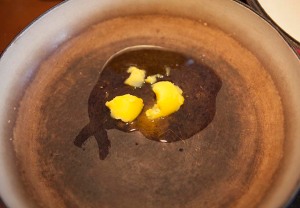
2) Brown the chicken pieces in two or three batches – don’t crowd the pan…
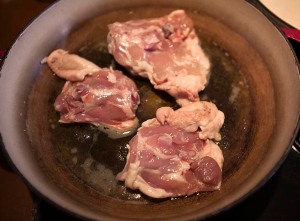
3) Once browned and sealed, set the chicken pieces aside…
4) Add the onions and carrots to the same pan and saute until well browned, stirring every-so-often – about 10 minutes…
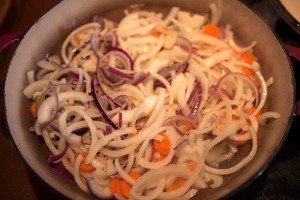
5) When the vegetables are well browned add the chopped garlic, and cook stirring for a further 2 minutes…
6) Return the chicken to the pan, placing the pieces on top of the vegetables…
7) Add enough stock to just cover the vegetables and bring to the boil – then add the seasoning and cover the pot with a tight fitting lid. Finally turn down the heat to very low and simmer for about 80 minutes…
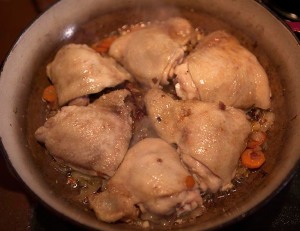
8) Ready to serve!
(At this stage, if you are making the dish for a dinner party and you want to impress, you can make a thickening einbren – a kind of Jewish beurre manie, only made with schmaltz, not butter. Firstly remove the chicken and all the solids from the pot and place neatly onto 4 heated plates. Then, simply melt another 2 tablespoons of schmaltz in a small saute pan before adding two tablespoons of plain white flour. Cook until the flour goes brown and just begins to burn. Then, a small ladle at a time, add the liquid from the chicken pot until it is all incorporated and you have a rich, emulsified sauce. Finally, spoon a portion of the “einbren” over the chicken on the plates.)
9) Plate up and serve…
Here, I served the chicken with a tzimus of carrots and beans and mashed potato. Mash is fine but this works best with potato latkes.
Make sure you have a hearty red wine to wash it down and enjoy.
Betay avon!!


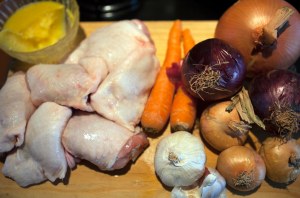
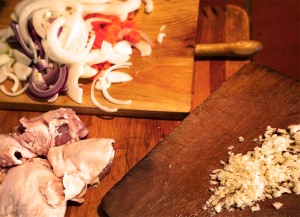
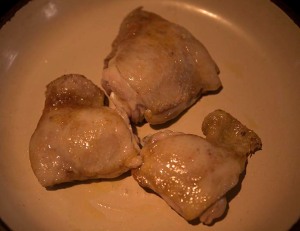
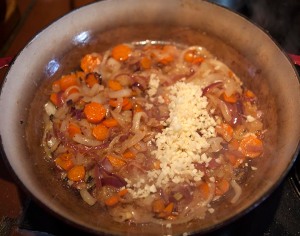
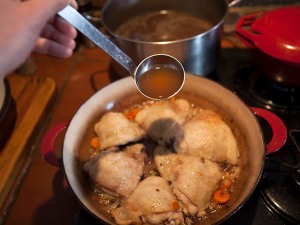
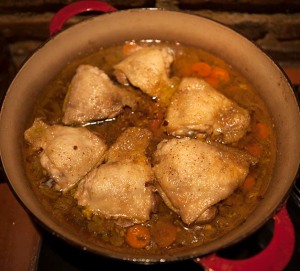
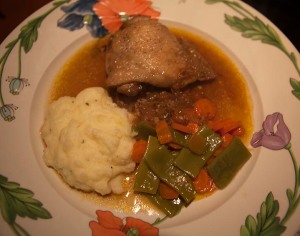
Thank you so much for this lovely recipe. Many of the others for Gedempte Chicken looking too plain.
My mother made a dish which I think was Dutch descent. It was called Peas and Clice (not sure of spelling). Would you know the recipe? Thanks. Lynda
LikeLiked by 1 person
Not familiar with “clice” (is it a Dutch expression?) Lynda although it might be referring to einbren of carrots and peas, which is similar to carrot tzimmus, with the addition of peas. Next time I make it and my camera’s to hand I’ll post it up, as it’s delicious. If you don’t want to miss it you’d better follow this blog, and many thanks for your kind comments. Otherwise there’s a very reliable, no-nonsense recipe for it in an old British published book called “Gourmet’s Guide to Jewish Cooking” by Bessie Carr and Phyllis Oberman (ISBN-10: 0907812244 – still available second hand)…
LikeLike
I think you will find it’s peas and KLEIS which means dumpling in German. My mother in law made it but I don’t have recipe but would like one if you can find it.
LikeLike
I’ll have a look through my books and see if I can find anything. I’ll let you know.
LikeLike
Nothing here in my own modest library of Jewish cookbooks and the mentions on line – as you’re probably aware – are fairly tangential. The one thing I’ve managed to establish thus far is that the dumplings you mention are made from a batter of some kind and then dropped into a pot of minted peas. All most intriguing…
LikeLike
My grandma in England made this by boiling freshly shelled peas in salted water, with about 2 lbs of unsalted butter ( yes really! ) . When the peas were tender huge dollops of thick batter ( flour eggs milk salt and pepper – like a yorkshire pudding batter but thicker) are dropped into the water off of a large spoon. It sticks to the peas and makes a decadent rich dish. It was served in soup plates.
LikeLiked by 1 person
Love this gedempte chicken! I’ve made it three times, and we all love it, even The littlest grandchild (she’s 4). Only I brown everything in light olive oil (wimpy I know, but the fat present in the chicken parts carry the shmaltzy flavor.
LikeLike
Thanks Joy, although I can’t say I’m convinced by the olive oil component. Not that I don’t love cooking with olive oil, it’s just not the same dish as that made in pure schmaltz. Please do try it, at least once and I bet you that your grandchild will like it even more, especially if you do the thickening einbren too! Shabbat shallom
LikeLike
My mother used to make peas and kleis it consisted of a lamb stew cooked on top of the stove. It was cooked slowly with cubed lamb and frozen peas, when cooked she took ladle of gravy and mixed with seasoned flour and made a loose mixture and dropped back into the stew.
LikeLiked by 1 person
Hi Adam, your great Auntie Ray was my mother in law. So nice to read you, specially about your mother.
Keep well in those difficult times.
Josee (Dennis’s wife)
LikeLiked by 1 person
Great to hear from you Josee! I think I might have met you once in Edgware, sometime around the late 70’s – early 80’s? Though I could be wrong? If you’d like to establish a better contact, perhaps you could leave your email address on my art purchasing page (NO purchase required!! 😉). I have several photos of Ray and Ben, and one or two of a very young Dennis which might be new to you, if you’re interested? If not, I understand. In any event, I wish you, Dennis and your family all the best…Adam
LikeLike
Apologies Josee, but I just realised that with my new-look site I seem to have mislaid my contact page (I’m working on getting it back). For now, you can establish contact with me via my LinkedIn page, here: https://www.linkedin.com/in/adam-green-865b09a5/
LikeLike
Hello again Josee, just to let you know that I reverted to my old theme and installed a contact button at the top of the page. Hope to hear from you… Adam
LikeLike
HI again Josee. Just in case you do want to make proper contact I just sorted out an issue with my contact page. I hadn’t realised that it had reverted to WordPress’s example page. Also, you might find my latest blog interesting, as Ray features… Best wishes etc…
LikeLike
What a coincidence. I had an Aunty Ray and my son’s name is Adam, but I’m not related to any of you. I grew up in Essex. Another coincidence is that her mother (my grandmother) was of Dutch decent and made peas and kleis. (I remember them as dumplings with peas in them).
LikeLike
Ah! But did your Adam’s great Aunty Ray make great gedempte chicken!? Maybe that was a Middlesex thing (we all being from Edgware)…😉😊
LikeLike
Not that I remember. It sounds a bit too Ashkenazi, considering we are a Sephardi family (-: But it looks delicious, I’m going to try it!
LikeLiked by 1 person
Betay avon Sara! For when you eat it!
LikeLike